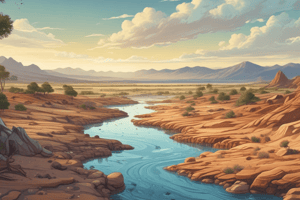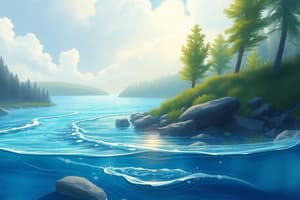Podcast
Questions and Answers
What defines water scarcity?
What defines water scarcity?
- The ability to use water without impacting ecosystems.
- An increase in water availability due to climate changes.
- An excess of water resources in a region.
- The lack of sufficient available water resources to meet regional demands. (correct)
Which of the following factors does NOT affect water availability?
Which of the following factors does NOT affect water availability?
- Human action
- Overexploitation of resources
- Technological advancements in water purification (correct)
- Climate
What can individuals do to support water conservation efforts?
What can individuals do to support water conservation efforts?
- Critique the need for policies on water usage.
- Ignore local water conservation programs.
- Create informative content promoting water-saving practices. (correct)
- Advocate for unrestricted water usage.
Which statement about water availability is accurate?
Which statement about water availability is accurate?
How can overexploitation of water resources be described?
How can overexploitation of water resources be described?
What is the primary source of rivers and lakes?
What is the primary source of rivers and lakes?
Which of the following is NOT considered surface water?
Which of the following is NOT considered surface water?
What is a significant disadvantage of surface water?
What is a significant disadvantage of surface water?
Which of the following statements about groundwater is true?
Which of the following statements about groundwater is true?
What type of water resource is a pond classified as?
What type of water resource is a pond classified as?
What role do oceans play in the Earth's ecosystem?
What role do oceans play in the Earth's ecosystem?
What is a common method used to access groundwater?
What is a common method used to access groundwater?
Which condition can lead to the depletion of groundwater resources?
Which condition can lead to the depletion of groundwater resources?
What is the chemical formula for water?
What is the chemical formula for water?
Which state of water is characterized by its ability to flow and take the shape of its container?
Which state of water is characterized by its ability to flow and take the shape of its container?
What percentage of Earth's water is classified as freshwater?
What percentage of Earth's water is classified as freshwater?
Where is most of Earth's freshwater primarily located?
Where is most of Earth's freshwater primarily located?
Which of the following contributes to the availability of groundwater?
Which of the following contributes to the availability of groundwater?
Which of the following best describes water vapor?
Which of the following best describes water vapor?
What percentage of Earth's surface is covered by water?
What percentage of Earth's surface is covered by water?
Which statement about the role of water on Earth is true?
Which statement about the role of water on Earth is true?
Flashcards are hidden until you start studying
Study Notes
Water Resources on Earth
- Water, essential for life, consists of two hydrogen atoms and one oxygen atom (H₂O).
- Covers approximately 71% of Earth's surface, primarily as oceans (96.5% saltwater, 2.8% freshwater).
- Found in three states:
- Liquid (flows and takes shape of its container).
- Solid (ice, less dense than liquid).
- Gas (water vapor, colorless and odorless).
Types of Freshwater Sources
- Freshwater represents only 2.8% of Earth's total water; vital for human and environmental needs.
- Glaciers and Ice Caps:
- Store the majority of freshwater, mainly located in Antarctica and Greenland.
- Groundwater:
- Found in aquifers, essential for drinking and irrigation.
- Surface Water:
- Includes lakes, rivers, and streams, driven by precipitation and snowmelt.
- Critical for human activities: drinking, irrigation, and recreation.
Surface vs Groundwater
- Surface Water:
- Includes rivers, lakes, reservoirs, and oceans.
- Influenced by pollution and overconsumption.
- Groundwater:
- Cleaner and more reliable; obtained through wells and springs.
- Vulnerable to contamination and overuse.
Water Availability and Scarcity
- Water availability refers to the quantity of water usable for human purposes without harming ecosystems.
- Water Scarcity:
- Occurs when water availability fails to meet the demands of a region, influenced by natural conditions and human actions.
Factors Affecting Water Availability
- Climate: Influences precipitation and evaporation rates.
- Geography: Determines water source access and distribution.
- Human Action: Activities can lead to pollution and over-exploitation.
Addressing Water Scarcity
- Engage in water conservation and promote sustainable practices.
- Encourage awareness through platforms like TikTok to showcase effective water-saving strategies.
- Reflect on personal actions and influence peers towards responsible water usage.
Studying That Suits You
Use AI to generate personalized quizzes and flashcards to suit your learning preferences.




